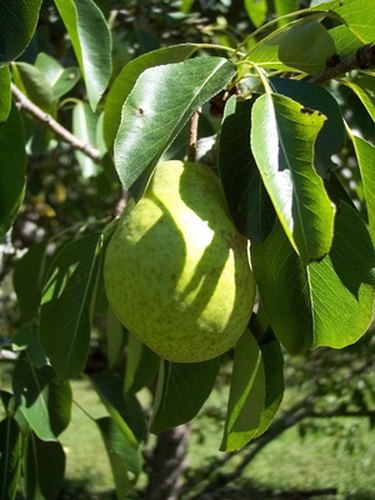
Indianapolis, Indiana is located in south central Indiana. The fruit trees that will grow well in this area are those classified in USDA hardiness zone 5. The USDA hardiness zone map is a guide for gardeners to aid them in plant selection. Plants are categorized based on the lowest temperature that they can tolerate. In this zone, plants can tolerate winter temperatures as low as -10 to -20 degrees Fahrenheit. Many fruit trees have specific soil and moisture requirements. Test your soil prior to planting. Soil test kits are available at garden and home improvement centers.
Bing Cherry
Video of the Day
The bing cherry is one of the most well-known and finest cherries available. It is a native tree found both on the eastern and western coasts of the United States. It is tolerant for zones 5 to 9. Like many fruit trees, it is a member of the Rose family. In the proper conditions, the bing cherry tree will grow up to 35 feet high. It prefers full sun in well-drained, sandy soils. The tree takes about five to six years to produce fruit. Harvest is mid-June to mid-summer. Its tasty fruits are relished by songbirds. Deer will also nibble on its foliage and twigs.
Video of the Day
Common Pear
The common pear is another fruit-bearing tree of the Rose family. It will grow well in zones 5 to 8. It requires full sun in slightly acidic to acidic soil conditions. It is a medium-size tree, reaching heights up to 20 feet. Smaller dwarf varieties are also available at garden centers. The common pear thrives in well-drained soils, as it is not drought tolerant. Like bing cherry, it takes about five years to produce its first fruit. Harvest for its delicious golden fruits is mid-August to mid-September.
Burbank Plum
The Burbank or Japanese plum is a Japanese cultivar, suited for zones 4 to 8. It is a medium-sized fruit tree, reaching heights up to 35 feet. Dwarf varieties are also available. It bears fruit earlier than other plum varieties. It produces red-colored fruit with yellow flesh, and is the most popular commercial variety. Like other fruit trees, the Burbank plum prefers full sun in non-alkaline, well-drained soils. Some pruning is required to maintain its shape and help prevent disease. It will produce fruit in about four years. Fruits begin to ripen in mid-summer, with the best harvest before the fruits are completely ripe.
Red Mulberry
Red mulberry is native to the eastern half of the United States into Canada. This medium-sized tree can reach heights up to 50 to 70 feet. It is a rapidly growing tree that's tolerant of a variety of soil conditions. It prefers full sun to partial shade found in locations within zones 5 to 8. Its berry-like fruit resembles blackberries, though the two plants are not related. The red mulberry will attract birds and butterflies, making it a good choice for a wildlife garden.